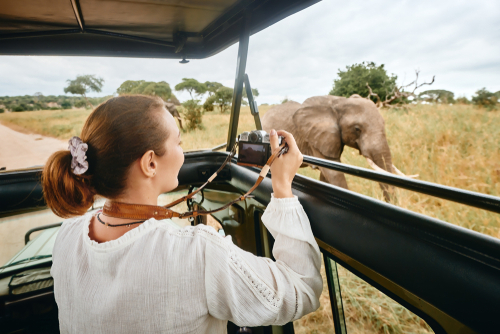It’s no secret that people all over the world are itching to travel again. While some travelers find joy in visiting well-known places because it allows them to feel a sense of community in the shared experience, others prefer to explore untouched lands. As we wait for travel restrictions to ease up again, what better way to pass the time then to plan for your next vacation?
If you’re the kind of person who yearns to adventure to lesser-known destinations, read on for four helpful travel planning tips. By the time international travel gets the green light, you can be the first person to make your way to your undiscovered destination of choice!
But how does one locate or plan a trip to places considered “off the map?” As crazy as it sounds, almost every region has places that qualify as largely undiscovered. The world is large and you can still find places almost anywhere, even in New York City, that are mostly untouched by tourist footprints.
Fortunately, today’s travelers can use technology to find these hidden locations. This article will show how to plan a trip to an undiscovered area, what to look for in locating these elusive spots, and things to consider as you pack for the unknown.
Do Some Research First
The internet is teeming with travel blogs and stories of far-flung locales. Do some reading early on and keep a list of lesser-known places that other travelers have talked favorably about.
Is this destination close to any major airports or a populated capital city? Will you be required to rent a private vehicle? Is there public transportation? What accommodations, if any, are near to where you’re going? You can look at flight, train, and other transportation methods once you know just how remote your chosen spot is.

Another tip is to speak to locals of the nearest big city where you want to go. Whether these conversations happen online or in person, talking to residents is a smart way to learn how to safely get where you want to go.
One thing not to do is to set out for parts unknown equipped with nothing more than your backpack and hopes. Traveling to undiscovered areas comes with a certain amount of risk. There are likely fewer hospitals, fewer people, rougher roads, and poorer cell service. All of this requires careful consideration.
Let World Heritage Sites Lead the Way
How do you locate a place that is undiscovered? One way to narrow your search for an undiscovered travel destination is to look at designated World Heritage Sites. The United Nations Educational, Scientific, and Cultural Organization (UNESCO) lists hundreds of places considered to be some of the most precious and rare in the world.
Check out vacation rentals near your place of interest. Look at group tours that might journey close to landmark regions. Even if you’re handling the trip on your own, you can lay the groundwork for what you might need to pack by looking at published itineraries related to that general region. You can also get a ballpark idea of your budget by studying guided tours around UNESCO World Heritage Sites.
What to Consider When Traveling to Undiscovered Areas
Choosing to venture to areas that don’t handle as much foot traffic comes with many special considerations. A few vital points of interest include:
- Local culture. Everything from dress code to the availability of businesses to assist you will be impacted by the local culture. Some places observe sabbaths on different days, have rules about what can and can’t be worn in public, and may have different values than what you’re used to. Make sure you’re prepared for the local culture before venturing out.
- Wildlife and green habitats. The same reverence needs to be paid to the flora and fauna. Perhaps there are animals that often intrigue travelers but should not be fed or petted and green spaces that are forbidden to make camp in. Is your destination largely viewed as seasonal, and what changes do you have to think about if you go during the offseason? These are all considerations that can prevent you from running into trouble.
- Language. The ability to communicate with locals is crucial. While the point of a sojourn to an undiscovered area might be to avoid people as much as possible, you shouldn’t expect to complete such a journey without talking to a few locals. Learning some basic phrases in the dominant language will not only help you get around, but it’s also a sign of respect.
- Provisions. Will you be hiking or biking to get to any part of where you plan to go? Is this a road trip? Carrying the right provisions should be part of your plan. Even experienced hikers and campers need to expect delays, unpredictable weather, and other circumstances that might require them to have more food, water, and clothing than normal. You want to overestimate rather than underestimate something as necessary as food and your ability to keep warm when planning a trip to an undiscovered place.
How Remote Is Remote?
Everyone has a different idea about what “undiscovered” means. For some, this could be a weekend in the more silent domains of the Moab desert. Others may think of a day trip through uncharted forests in Croatia. Whether you have trekking up volcanic peaks in the Caribbean or a fairytale hot spot in Iceland on your bucket list, having a clear understanding of how isolated you’ll be is key when planning trips to lesser-known locales. Print out several copies of maps and contact information for the nearest embassies, lodgings, and emergency services. Keep these documents in multiple places within your luggage to ensure you don’t lose them.
Also, consider hiring a professional guide. Many places offer “wild” experiences that are still managed by a touring service that can monitor your progress through a safari, jungle excursion, or any other outdoor activities without infringing on your privacy or the world-class natural beauty you’ve come to enjoy.

Local guides can be invaluable when it comes down to getting assistance in unknown territories. They can likewise suggest things for you to do, such as kayaking down the Amazon River, snorkeling at pink sand beaches, hiking up mountain ranges in South America, or visiting Buddhist temples along the Silk Road. From boat rides to the best beaches, it’s a good idea to find a local guide to assist your wanderlust.
No matter how independent you are as a beaten-track traveler, never go to an undiscovered area without making your plans known. Someone needs to know where you are and when you’re expected to be back.
Find Undiscovered Areas With VacationRenter
Traveling to an undiscovered area can be exciting, but getting the most out of your trip means educating yourself as much as possible before you go. Whether you’re looking to experience the street art of Portugal, trek the sand dunes of the Middle East, or want to experience old-town ways of life in Poland, take your search for the best secret spot to the next level with VacationRenter. VacationRenter’s online platform compiles accommodations from the top sites in one place so you can focus more on planning your next adventure and less on finding a place to sleep.